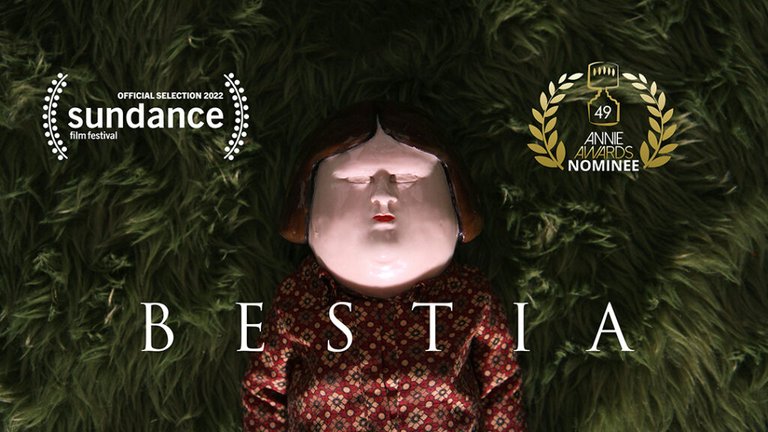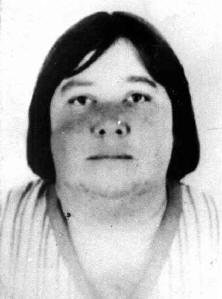Bestia (2021): torture, horror and impunity | tortura, horror e impunidad

Nominado al Oscar como Mejor Cortometraje Animado
This week marks the national holidays in Chile, the most important date of the year for Chileans and in addition to holding festivals, games, concerts and barbecues, there is space for reflection on the history of the country, from the distant era of independence to the not-so-distant military dictatorship and the last decades. In this commemorative framework, MUBI has uploaded to its platform four Chilean short films that have been recognized and awarded around the world in recent years.
Esta semana se celebran las fiestas patrias en Chile, la fecha más importante en el año para los chilenos y además de realizar fondas, juegos, conciertos y asados, hay espacio para la reflexión sobre la historia patria, desde la lejana época de la independencia hasta la no tan distante dictadura militar y las últimas décadas. En ese marco conmemorativo, MUBI ha subido a su plataforma cuatro cortometrajes chilenos que han sido reconocidos y premiados en el mundo en los últimos años.
I already posted a review of Los huesos a few months ago and although I haven't posted one of Historia de un oso, a short film released in 2014 that won an Oscar, I think most people have heard of it. Another short that was much talked about, precisely for having received an Academy Award nomination, was Bestia, directed by Hugo Covarrubias and co-written by him with Martín Erazo. I remember that they had some screenings in movie theaters and public libraries, but there was so much interest in this film that I couldn't get into any of those screenings, so I had to wait until now to see it. I didn’t know exactly what it was about, but I did know that it was linked to Ingrid Olderöck because at the same time that people were queuing to see the short film, the bookstores’ windows were filled with copies of Ingrid Olderöck: la mujer de los perros by Nancy Guzmán, promoted precisely for talking about the character portrayed in Covarrubias’ work. Given the title of the book, the title of the short film, and knowing the thematic obsession that Chilean narrators, researchers, and filmmakers have with the military dictatorship (it’s a bit like what happens in the world with the Second World War and the Holocaust, which seems to be an inexhaustible topic), one can intuit that this woman had some kind of relationship with Augusto Pinochet’s forces, but who was Ingrid Olderöck?
Ya subí una reseña de Los huesos hace algunos meses y aunque no he subido una de Historia de un oso, cortometraje estrenado en 2014 y que se llevó el Oscar, creo que la mayoría de las personas han oído hablar de él. Otro corto que dio mucho de qué hablar, precisamente por haber recibido una nominación a los premios de la Academia, fue Bestia, dirigido por Hugo Covarrubias y co escrito por él junto a Martín Erazo. Recuerdo que realizaron algunas proyecciones en salas de cine y bibliotecas públicas, pero era tanto el interés que despertaba esta obra que no pude ingresar a ninguna de esas funciones, así que tuve que esperar hasta ahora para verlo. No sabía exactamente de qué trataba, pero sí que estaba ligado a Ingrid Olderöck porque al mismo tiempo que las personas hacían fila para ver el cortometraje, las vitrinas de las librerías se atiborraban de copias de Ingrid Olderöck: la mujer de los perros de Nancy Guzmán, promocionado precisamente por hablar del personaje retratado en la obra de Covarrubias. Por el título del libro, el título del corto y por conocer la obsesión temática que tienen los narradores, investigadores y cineastas chilenos con la dictadura militar (es un poco como lo que ocurre en el mundo con la segunda guerra mundial y el holocausto que parece un tema inagotable), uno puede intuir que esta mujer tuvo algún tipo de relación con las fuerzas de Augusto Pinochet, pero ¿quién fue Ingrid Olderöck?

I don't want to narrate what the documentary shows because it lasts only 15 minutes, so anything I say would represent a good part of the plot. And although there are certainly things that can be inferred from one or another clue, the short length of the work may prevent some people from understanding important things. So I prefer to talk a little about the character portrayed so that those who dare to watch the documentary can recognize some things and appreciate the approach taken by the director.
No quisiera narrar lo que muestra el documental porque dura apenas 15 minutos así que cualquier cosa que diga representaría una buena parte de la trama. Y aunque ciertamente hay cosas que se infieren a partir de uno que otro indicio, la corta duración de la obra puede impedirle a algunas personas comprender cosas importantes. Así que prefiero hablar un poco del personaje retratado a fin de que, quienes se animen a ver el documental, puedan reconocer algunas cosas y apreciar la aproximación hecha por el director.
Chilean by nationality, but of German parents with Nazi affiliation, Ingrid Olderöck was an officer of the Carabineros of Chile who worked as an agent of the National Intelligence Directorate (DINA), something like the Chilean Gestapo, since 1973, the year of Pinochet's coup against Salvador Allende. The number of atrocities that were committed in the shadows during the dark years of the military dictatorship in Chile is undeniable, innumerable and incredible. Detention centers, missing persons, torture houses, detainees, tortured, mass graves, the list is almost as long as the names of the victims. We all know what happened in Villa Grimaldi, we have seen the documentaries of Colonia Dignidad and in that context Ingrid Olderöck is another cog in a nefarious power machine. However, that doesn't make her crimes any less atrocious. The reason this woman was known as the dog lady is because in the basement of La Discotéque (the detention and torture centre where she carried out her functions) Olderöck was in charge of directing a dog that, trained for this purpose, sexually assaulted the detainees (torture copied from the manual of Klaus Barbie, the butcher of Lyon), while loud music played at full volume in the room (hence the name by which the place was known), how many of the tortured people subjected to this experience will have survived to tell the tale? Surely very few.
De nacionalidad chilena, pero de padres alemanes con filiación nazi, Ingrid Olderöck fue una oficial del cuerpo de Carabineros de Chile que trabajó como agente de la Dirección de Inteligencia Nacional (DINA), algo así como la gestapo chilena, desde 1973, el año del golpe de estado de Pinochet a Salvador Allende. Son innegables, innumerables e increíbles la cantidad de atrocidades que se cometieron en las sombras en los oscuros años de la dictadura militar en Chile. Centros de detención, desaparecidos, casas de torturas, detenidos, torturados, fosas comunes, la lista es casi tan larga como la de los nombres de las víctimas. Ya todos sabemos lo que pasó en Villa Grimaldi, hemos visto los documentales de la Colonia Dignidad y en ese contexto Ingrid Olderöck es un engranaje más de una nefasta maquinaria de poder. Sin embargo, eso no hace que sus crímenes sean menos atroces. La razón por la que a esta mujer se le conoció como la dama de los perros es porque en el sótano de La Discotéque (el centro de detención y tortura en donde ejercía sus funciones) Olderöck era la encargada de dirigir a un perro que, amaestrado para ello, violentaba sexualmente a los detenidos (tortura calcada del manual de Klaus Barbie, el carnicero de Lyon), mientras una música estridente sonaba a todo volumen en la habitación (de allí el nombre con el que se le conocía al lugar), ¿cuántos de los torturados sometidos a esta experiencia habrán sobrevivido para contarlo? Seguramente muy pocos.

The short film shows some of Olderöck's actions as a member of the DINA, the torture, the missing people, the attack on the lady of the dogs, but it also shows his daily life, his routine at home, with his pet. In fact, Beast begins with a homely tone and with each minute that the story progresses it becomes darker and darker, to the point that the feeling it leaves extends in the viewer far beyond its short duration.
El cortometraje muestra parte de las acciones de Olderöck como miembro de la DINA, las torturas, los desaparecidos, el atentado que sufrió la dama de los perros, pero también muestra su vida diaria, su rutina en casa, con su mascota. De hecho, Bestia inicia con un tono hogareño y a cada minuto que avanza la historia se va volviendo más y más turbia, al punto de que la sensación que deja se extiende en el espectador mucho más allá de su corta duración.
I am a fan of stop-motion animation and in this case of the combination of this technique with the aesthetics of porcelain dolls, since this material allows for a very good representation of the inexpressiveness and hardness of the protagonist's features. In addition to the aforementioned book by Nancy Guzmán, Covarrubias used other sources such as Historia secreta de Chile by Jorge Baradit and Los malos by Alejandra Matus and from there and together with Martín Erazo he wrote a very good script that uses non-linear time, dreamlike representations and some symbolism and metaphors to tell a Dantesque story that should be as surreal as Dali's paintings, but unfortunately deals with events that really happened. Perhaps the most painful thing about this story is not only everything that Olderöck did (and what others like her did) or the fact that she survived a gunshot wound to the head (that toughness of the evil) but that she died in 2001, at the age of 57, in the same city of Santiago where she was born and did not spend a single day in jail. All the torture she inflicted and the human rights violations she committed went unpunished. And that is why there is still so much talk about the military dictatorship, so that something similar does not happen again. Have any of you seen this short film? I'll read you in the comments.
Soy fan de las animaciones en stop-motion y en este caso de la combinación de esa técnica con la estética de las muñecas de porcelana, ya que este material permite representar muy bien la inexpresividad y la dureza de los rasgos de la protagonista. Además del mencionado libro de Nancy Guzmán, Covarrubias utilizó otras fuentes como Historia secreta de Chile de Jorge Baradit y Los malos de Alejandra Matus y a partir de allí y junto a Martín Erazo escribió un muy buen guión que utiliza el tiempo no lineal, las representaciones oníricas y algunos simbolismos y metáforas para contar una historia dantesca que debería ser tan surrealista como las pinturas de Dalí, pero que desafotunadamente trata de hechos que realmente ocurrieron. Quizá lo más doloroso de esta historia no es sólo todo lo que Olderöck hizo (y lo que otros como ella hicieron) o el hecho de que sobrevivió a una herida de bala en la cabeza (esa dureza de los malvados) sino que murió en el año 2001, a la edad de 57 años, en la misma ciudad de Santiago que la vio nacer y no estuvo ni un sólo día en la cárcel. Todas las torturas que infligió y las violaciones de derechos humanos que cometió quedaron impunes. Y por eso aún se habla tanto de la dictadura militar, para que no ocurra de nuevo algo parecido, ¿alguno de ustedes ha visto este cortometraje? Los leo en los comentarios.
Reseñado por @cristiancaicedo
Other posts that may interest you | Otros posts que pueden interesarte:
   |
|---|



